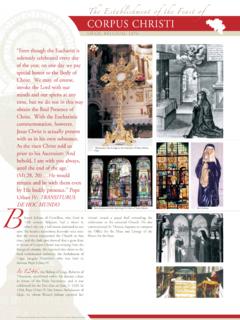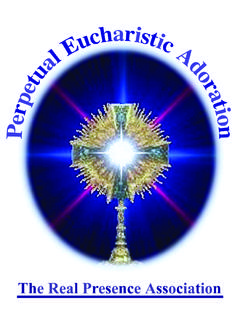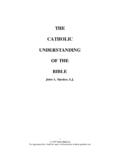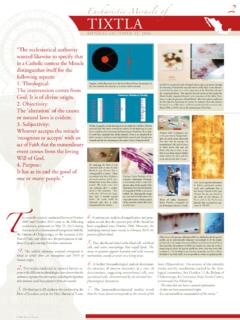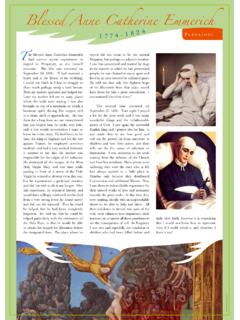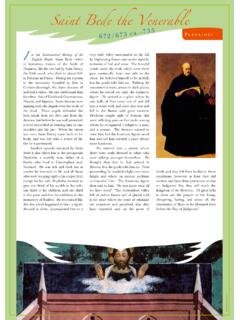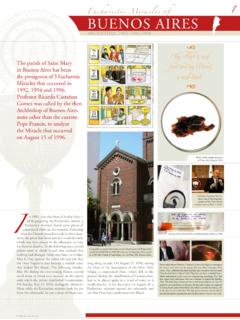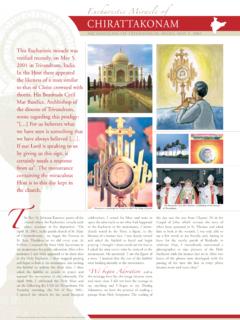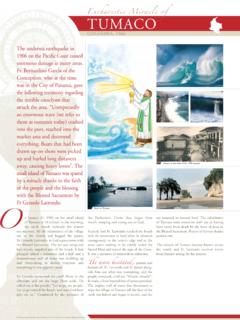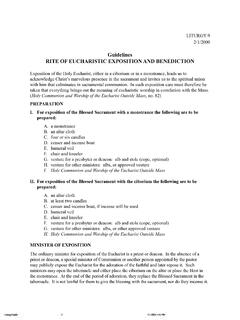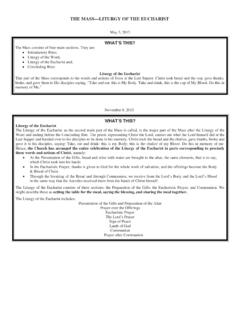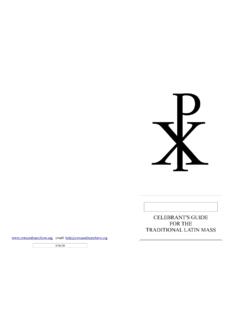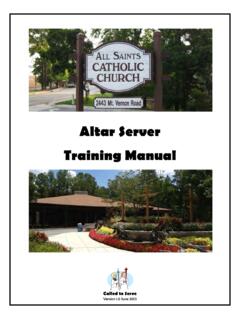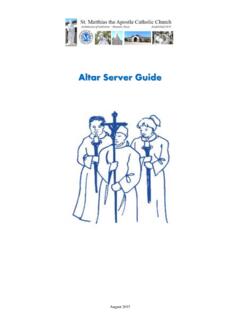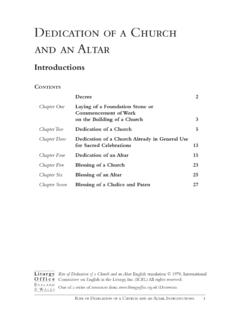Transcription of The liturgical objects used for the Eucharist
1 210 Chapter VII The liturgical objects used for the Eucharist 211 69 HOW MANY ARE THERE AND WHAT ARE THEY? There are many objects and each one has its own specific meaning and function. Here are the ones that concern: The altar : The cross: with the figure of Christ in the center. The cross is: The instrument of Christ s Passion and glorification, just as he himself foretold as his Passion approached: Now is the Son of Man glorified, and God is glorified in him. 32If God is glorified in him,[c] God will glorify the Son in himself, and will glorify him at once (Jn 13,31). It is a Sign: - of the presence of salvation, and also of the the hope of salvation in Christ; - of the universal dimension of salvation: the arms of Christ were opened wide as he was lifted up on the Cross in his desire to embrace men and women of all times and places.
2 - of the newness of the Christian identity with which it becomes associated; - - of Christian values that are characterized with certain societies and cultures; - of the Son of Man (Mt 24,30) who will appear at the end of time; - of the ultimate and supreme victory of good over evil (cfr. Gal 6,14). We are reminded that all who follow Christ are called to share in his suffering: If anyone wishes to come after me, let him renounce himself, take up his cross and follow me. (Mk 8, 34). 212 The bread made from wheat and the wine made from grapes. The chalice: is a cup made from precious metal with its inner surface covered in gold that holds the Most Precious Blood of Christ.
3 1 Chalice 2 Chalice with paten 1 2 213 The paten: a precious circular dish made from solid metal that is used to contain the host both before and after the consecration. It is slightly concave or has, in its center, a slight depression so as to contain the host more securely. The cruets: these are glass containers or small jugs made from another material that are used to hold the water and wine. The water: a few drops of water are added to the chalice during the offertory. Some of the water is also used to wash the priest s hands as well as to purify the chalice at the end of the Holy Mass. 214 The altar cloth: this is a white linen cloth that is used to cover the entire surface of the altar . The flowers: (if there are flowers used ): different colors are chosen so that the flowers are in harmony with the altar and the liturgical season.
4 215 The missal: this is a book that contains all the texts that are necessary for the celebration of the Holy Mass. The lectionary: this is a book that contains the readings taken from Sacred Scripture The book stand: this is a liturgical accessory used to hold the sacred books (at the ambo, the chair or the altar ) 216 The purificator: this is a small linen cloth, approximately the size and shape of a handkerchief, that is used to dry the chalice, to wipe the paten and the rim of the chalice after a person has received from the chalice. The finger towel: a linen cloth that is used by the priest to dry his hands at the Offertory after he has washed his hands. The pall: this is a small square cloth, often rigid or made from heavy material, that is placed on top of the chalice.
5 The images represent the corporal, the purificator, the finger towel and the pall. 217 The candles: as they burn they represent the prayers and the life of the members of the faithful as they give themselves to loving God and neighbor. 1 2 1 The candle burns and gives light. As it burns it gets used up. The candle is a symbol of Christ, the light who enlightens us and warms our hearts. He gave himself for us all. The candle is also a symbol of the Christian who brings Christ s light in the world and who inflames his heart with love for God and neighbor. 2 The Easter Candle, or the Paschal Candle, is a symbol of the risen Christ, true light of the world who enlightens every person. It is a sign of new life in Christ who saved us from sin and has opened to us the gates of Paradise. 218 The pyx or ciborium: this is a container used to safeguard or to bring Holy Communion under the form of bread.
6 The bell. 219 The thurible (usually called this): is often made from precious silver with three sets of long chains that allow a dome-shaped lid to slide up and down the chains. These chains are gathered together by a type of cover in the shape of a lid. On top of the lid is a large silver ring which allows the thurible to be held easily. Inside the thurible is another dish in which burning coals are held securely. Grains of incense are scattered on the burning charcoals and plumes of smoke appear through the openings in the lid of the thruible. The chains of the thurible remind us of our prayers that are linked to each other, uniting us with Heaven, bringing us into communion with God. As the incense burns it rises up into the air. This is a sign: of God s divinity and oneness (in the past many Christians paid with their very lives for their refusal to offer incense to the pagan gods or human figures in authority who were given the status of gods); of our fervent prayer that is pleasing to God and rises before him.
7 220 The boat: (usually called this): is a container that has this name because of its shape and also because it is used to hold the grains of incense. The aspergillum: a small bucket often made from precious or semi- precious metal, and a sprinkler in the form of a small perforated globe which, when plunged into the bucket containing holy water, absorbs some of the liquid and then releases it when sprinkled. Both are used in the sprinkling of holy water. The jug and the bowl are used for the washing of the priest s hands: they are the objects he uses for the purification of his 2 hands during the offertory. While he is washing his hands the 1 priest says: Lord, wash 1 Jug away my iniquity, cleanse me from my sins.
8 2 Bowl 221 The monstrance: this is used to expose the Most Blessed Sacrament during adoration. 222 The celebrant s vestments: The amice: this is a white cloth that is worn around the neck when the alb does not cover the priest s clothes fully. The alb: this is a white garment made from cloth. It is a full length garment and touches the celebrant s heels. It is used to cover the priest s body completely. 223 The cincture: this is a type of belt or girdle that gathers the alb round the celebrant s waist. The stole: this is an important piece of insignia which looks like a long scarf and is worn by the priest and a Bishop around the neck.
9 A deacon s stole is diagonal in that it is worn transversely, that is, one end rests on the deacon s left shoulder and the other end is gathered together as it drapes on his right side. 1 2 1 cinture 2 stole 224 The chasuble or vestment: this is a garment worn by the priest over the alb and stole; there are different liturgical colors for the chasuble according to what is being celebrated. The beauty and careful handmade details of the vestments are a sign of the faith and love of the faithful, and they invite us to contemplate the beauty of God who is present in a special way in the Eucharist . The surplice: this is a long white garment, often decorated with lace, that reaches the knee, and has short but wide sleeves.
10 It is worn over a soutane or cassock. It is used also by altar servers when they serve at the altar . 225 The humeral veil: this is a cloth that is worn by the priest over his shoulders and it is used , in a sign of respect, to cover and uncover the monstrance during solemn Eucharistic benediction or during a procession during which the offerings are presented. The dalmatic: this is a vestment that is worn by a deacon. 226 The cope: a liturgical vestment originally used for processions and later for the more solemn Liturgy of the Hours on Feast Days as well as for the celebration of Sacraments outside Mass. It is also worn for Benediction of the Most Holy Sacrament. The Miter: is worn by the Bishop during solemn celebrations and underlines the importance of his Ministry.
